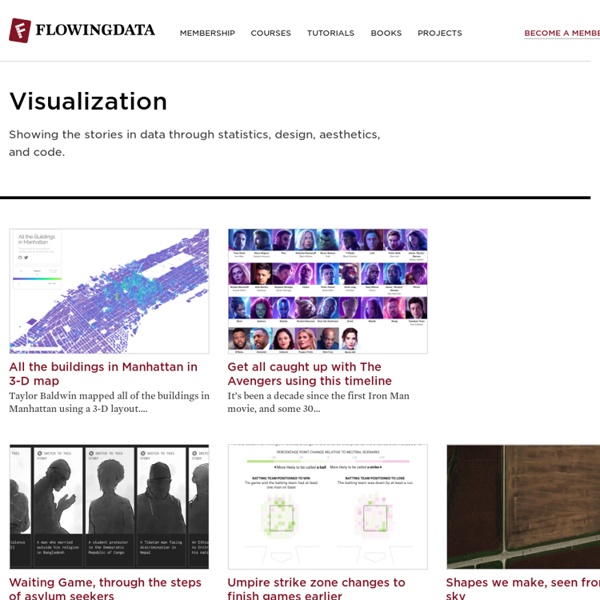



DataViz DataViz Mediaeater MMX Archive / RSS June 21 (Source: thedailywhat) May 26 April 30 December 5 (Source: mrharristweed) November 12 November 9 (Source: toukubo, via handa) November 3 September 3 August 15 (Source: thedailyfeed) Next » A Case Study In How Infographics Can Bend The Truth We’ve made the point time and time again that charts and graphs, though they feel official and true, can lie. Rarely do you get to see that at work, but the good folks at Hyperakt have sent us a prime case study in infographic deception. The subject, of course, is politics--and in particular, the raging debate over whether the rich should be made to pay more taxes. "Using the same data, very different stories can be told depending on different agendas," says Deroy Peraza, one of the founders of Hyperakt. A story from the Wall Street Journal's far-right op-ed page gets us started, with a chart showing how much taxable income is made by Americans ranging from the rich to poor: Looking at that, the conclusion seems glaringly obvious: The rich don’t make so much money! The chart most certainly does not demonstrate the Journal’s point. And look closer: The left side of the chart deals with people who make between $0 and $50K. Whoa whoa whoa! Top image: S.
nicolasrapp.com @rt-Histor-iTeck — De l'art,des histoires et de la technologie... Cool Infographics - Blog Interactive Dynamics for Visual Analysis Graphics Jeffrey Heer, Stanford University Ben Shneiderman, University of Maryland, College Park The increasing scale and availability of digital data provides an extraordinary resource for informing public policy, scientific discovery, business strategy, and even our personal lives. To get the most out of such data, however, users must be able to make sense of it: to pursue questions, uncover patterns of interest, and identify (and potentially correct) errors. Visualization provides a powerful means of making sense of data. The goal of this article is to assist designers, researchers, professional analysts, procurement officers, educators, and students in evaluating and creating visual analysis tools. Our focus on interactive elements presumes a basic familiarity with visualization design. Within each branch of the taxonomy presented here, we describe example systems that exhibit useful interaction techniques. Some visualization system designers have explored alternative approaches. 1.
iGraphics explained Why America's Healthcare Sucks You know it is true. According to the CDC, over 40 million Americans did not have health insurance during 2009. Obviously something has to change, but socialized medicine is not the answer. It is just one possible solution. Although smoking, drinking and the elderly are lower per capita in America than most European countries, it doesn’t mean we don’t have problems. I’m lucky to have some very affordable healthcare offered by my university. Prevention and price transparency could both be improved in the US. Share This Infographic Get Free Infographics Delivered to your Inbox Hand Jive After reading this infographic, the stadium full of University of Texas Longhorn fans holding up their hands in a symbol of team spirit has a whole new meaning. Apparently, the “longhorn” sign tells Mediterranean cultures that you have been cuckolded, or cheated upon. Texans traveling abroad, watch out where you show your Longhorn pride. Hand gestures, like culturally specific slang, do not always translate well across countries. I am sure this goes the other way around– does anyone know of any harmless hand gestures that translate into something derogatory in the United States? Share This Infographic Get Free Infographics Delivered to your Inbox
Matthew Ericson – ericson.net The winners of the 34th Edition of the Best of News Design contest were released today, so I’ve updated my interactive crosstab of SND winners that lets you see at a glance which publications won awards in which categories. One particularly interesting thing to me: There were only 19 awards give in the information graphics categories — 17 for individual works and 2 for portfolios. That’s down from 97 just three years ago. I’d be curious to know how much of the decline comes from fewer print graphics being produced in general in newspapers — and probably also fewer entries in the contest — and how much is from a different, and much tougher, set of judges than in past years. Just pushed out an update to the Adobe Illustrator MultiExporter script that lets you specify if you want to export PNGs and JPGs at a different scale factor so that you can generate versions of the images at double resolution for iPhone retina displays. I’ve posted the slides from my presentation as a PDF.
Why It Pays To Be Bilingual Being bilingual provides a variety of perks. Aside from giving you the ability to impress your latest love interest by reciting foreign poetry, being bilingual also pays dividends – monetarily, cognitively, and culturally. See the graphic below to find out why. Note to teachers, edubloggers and all those interested: Want to use this infographic in your class or share it on your blog? No problem! You’ll find a cool collection of classroom activities and sharing options below. (Click Image To Enlarge) Use This Infographic In Your Class We think that infographics are an awesome learning and teaching tool, so our creations will always be available for you to print out, use with your students and/or embed on your blog! Warm-Up Activity Before handing out the infographic, discuss the following question with your students: What are the advantages of being bilingual? Speaking & Critical Thinking Practice Questions to ask your students after presenting the infographic: Writing Challenge